
Ignaz Edler von Born, also known as Ignatius von Born, was a mineralogist and metallurgist. He was a prominent freemason, being head of Vienna's Illuminati lodge and an influential anti-clerical writer. He was the leading scientist in the Holy Roman Empire during the 1770s in the age of Enlightenment.

Sesbania is a genus of flowering plants in the pea family, Fabaceae, and the only genus found in tribe Sesbanieae. Riverhemp is a common name for plants in this genus. Notable species include the rattlebox, spiny sesbania, and Sesbania sesban, which is used in cooking. Plants of this genus, some of which are aquatic, can be used in alley cropping to increase the soil's nitrogen content. The species of rhizobia responsible for nitrogen fixation in Sesbania rostrata is Azorhizobium caulinodans.

Alamania punicea is a species of epiphytic orchids and the only species of the genus Alamania. It is endemic to Mexico and has two recognized varieties:

Crataegus laevigata, known as the midland hawthorn, English hawthorn, woodland hawthorn or mayflower, is a species of hawthorn native to western and central Europe, from Great Britain and Spain east to the Czech Republic and Hungary. It is also present in North Africa. The species name is sometimes spelt C. levigata, but the original orthography is C. lævigata.

Hygrocybe punicea, sometimes called Crimson- or Scarlet Waxy Cap, is a colourful member of the genus Hygrocybe, the waxcaps, found across Northern Europe. Originally described as Hygrophorus puniceus, it is the largest member of the genus.

Blandfordia punicea, commonly known as Tasmanian Christmas bell, is a species of flowering plant that is endemic to western Tasmania. It is a tufted perennial herb with linear leaves and drooping red, bell-shaped flowers that are yellow on the inside.
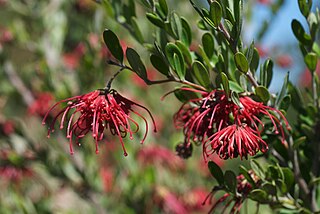
Grevillea speciosa, also known as red spider flower, is a shrub which is endemic to New South Wales in Australia.

Regelia is a genus of flowering plants in the family Myrtaceae and is endemic to the south-west of Western Australia. The genus is composed of five species of small leaved, evergreen shrubs which have heads of flowers on the ends of branches which continue to grow after flowering. Another species, previously known as Regelia punicea and which is endemic to Kakadu National Park in the Northern Territory, has been transferred to Melaleuca punicea.
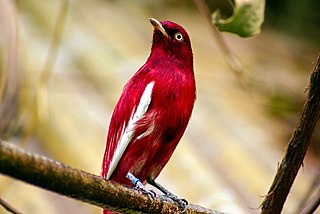
The pompadour cotinga is a species of bird in the family Cotingidae. This species lives in the Amazonian rainforest and has a range that extends across the Amazon Basin and includes Peru, Brazil, Colombia, Venezuela, and the Guianas. The pompadour cotinga is primarily a frugivore but has been known to consume insects on occasion. This species of cotinga is distinct in that the males have a burgundy head and body, bright white wings, and yellow eyes. Like other members of the Cotingidae, this species is sexually dimorphic and the females have a pale grey head and body. Although there are not many documented observations of the nesting behavior of these birds, the males are known to perform elaborate mating displays for the females who then raise the young alone.
Trochidrobia punicea is a species of very small freshwater snail, an aquatic gastropod mollusk in the family Tateidae.
Thorunna punicea is a species of sea slug, a dorid nudibranch, a shell-less marine gastropod mollusk in the family Chromodorididae.

Sesbania punicea is an ornamental shrub with reddish-orange flowers. It has deciduous leaves and grows to a height of 15 feet. This plant has a high demand for water, and thrives in swamps or wet areas. It requires a mildly acidic soil, with a pH between 6.1 and 6.5.
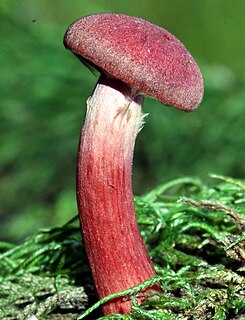
Tubaria punicea is a rare species of agaric fungus in the family Tubariaceae. It is found on the west coast of North America, where it grows on the bases and in hollows of madrone.
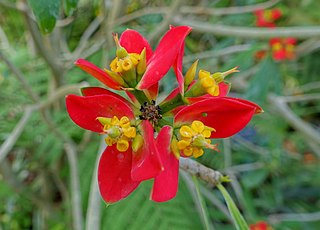
Euphorbia punicea is a species of euphorb commonly known as Jamaican poinsettia. It was first described by Olof Peter Swartz in his Nova genera et species plantarum seu prodromus. It grows as a bush or tree three to five meters (10–16 ft) tall, and sometimes much taller. The false flower is in fact a cyathium surrounded by large, colorful bracts.
Tenellia punicea is a species of sea slug, an aeolid nudibranch, a marine gastropod mollusc in the family Fionidae.

Melaleuca punicea is a plant in the myrtle family, Myrtaceae, and is endemic to the Northern Territory in Australia. Some of the characteristics of this species make it difficult to classify at the genus level. After it was originally described in 1984 as Melaleuca punicea, it was transferred in 1986 to the genus Regelia but it did not fit well in that genus either. In 1999 it was transferred again to a new genus Petraeomyrtus as P. punicea. Subsequent molecular studies, especially of chloroplast DNA have suggested that it is best placed in Melaleuca along with others from genera including Beaufortia, Callistemon and Regelia. Later publications include this species as Melaleuca punicea.
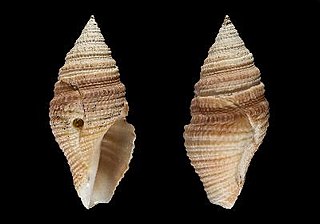
Bathytoma punicea is a species of sea snail, a marine gastropod mollusk in the family Borsoniidae.

Eurytellina simulans is a species of bivalve mollusc. This species was previously known as Tellina simulans. The animal was originally described to science by naturalist Charles Baker Adams, a professor of zoology at Amherst College. Adams left for an expedition to Panama in mid-November 1850. He collected furiously upon arrival and on January 3, 1851 shipped eight crates back to Massachusetts. These contained 41,830 specimens of 516 species of molluscs. He described Tellina simulans on the basis of a single valve.

Paradiarsia punicea is a moth belonging to the family Noctuidae. The species was first described by Jacob Hübner in 1803.
Eurytellina is a genus of bivalves belonging to the family Tellinidae.
















